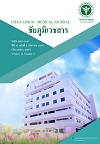Nursing care of patient Acute Stroke using Fast track system: Case study
Keywords:
Acute Stroke, Nursing care, Stroke Fast Track, Case StudyAbstract
Objective: To study the nursing care of stroke patients. Who came to Chaiyaphum Hospital With the expressway system as follows: 77-year-old Thai female patient refused congenital disease Coming to the hospital by EMS (Emergency Medical Services) the main symptom is the left-sided crooked mouth. Left limb weakness It was 1 hour and 40 minutes before coming to the hospital. The first diagnosis was Stroke Fast Track. Relatives about treatment Have relatives sign for consent for intravenous injection of rt-PA blood clots. The patient was administered rt-PA at the emergency room. Follow the guidelines for treatment of ischemic stroke patients (Clinical Practice Guidelines for Ischemic Stroke) and found nursing problems and diagnosis from caring for both patients at the emergency room as follows: 1) Risk of drug complications Dissolve blood clots (rt-PA) 2) risk of high intracranial pressure. 3) Risk of falling 5) Relatives have stress and anxiety in caring for the sick.
Conclusion: The patient comes to the hospital with the Emergency Medical Service (EMS) system when the command center nurse is informed that the patient has weak limbs. Qualified for acute stroke (Stroke Fast Track), therefore informed the rescuers Go out to pick up the patient immediately and inform the initial symptoms that they are eligible for Stroke Fast Track. Telephone symptom assessment It is important that practitioners have good experience and knowledge. The advantages of using the expressway system are fast, patient, safe. The recommendations from this case study of this patient were found in the Knowledge Assessment Telephone Triage of nursing center nurse and the knowledge of the community resuscitation team in the initial patient assessment Is important in this patient when the symptoms were quickly assessed over the phone Notify the community paramedics to receive the sick immediately. Causing the patient to arrive at the hospital quickly timely and safely.
References
กรรณิการ์ คงบุญเกียรติ, นรงฤทธิ์ เกษมทรัพย์, สมศักดิ์ เทียมเก่า, [บรรณาธิการ]. (2561). การรักษาผู้ป่วยโรคหลอดเลือดสมองในเวชปฏิบัติ. ขอนแก่น : โรงพิมพ์คลังนานาวิทยา.
สำนักงานปลัดกระทรวงสาธารณสุข. รายละเอียดตัวชี้วัดกระทรวงสาธารณสุข ประจำปีงบประมาณ 2563. [ออนไลน์]. http://bps.moph.go.th/new_bps/sites/default/files/Health%20KPI%2063.pdf [สืบค้นเมื่อ มิถุนายน 2563]
เกรียงศักดิ์ ลิ้มพัสถาน. (2553). โรคหลอดเลือดสมอง. เชียงใหม่ : หน่วยประสาทศัลยศาสตร์ ภาควิชาศัลยศาสตร์ คณะแพทย์ศาสตร์ มหาวิทยาลัยเชียงใหม่.
เฉง นิลบุหงา. (2561). ระบบประสาทและการทำงาน. พิมพ์ครั้งที่ 3. กรุงเทพมหานคร : โรงพิมพ์แห่งจุฬาลงกรณ์มหาวิทยาลัย.
มีชัย ศรีใส. (2554). ประสาทกายวิภาคศาสตร์. พิมพ์ครั้งที่ 4. กรุงเทพมหานคร : เยียร์บุ๊คพับลิชเชอร์.
โรงพยาบาลชัยภูมิ. (2563). ข้อมูลสถิติงานอุบัติเหตุฉุกเฉิน โรงพยาบาลชัยภูมิ. ชัยภูมิ : ศุนย์ข้อมูลและสถิติโรงพยาบาลชัยภูมิ.
กรมการแพทย์. (2558). แนวทางการพยาบาลผู้ป่วยโรคหลอดเลือดสมอง สำหรับพยาบาลทั่วไป (ฉบับสมบูรณ์ 2558). กรุงเทพฯ : สถาบันประสาทวิทยา กรมการแพทย์.
Downloads
Published
Versions
- 2021-08-17 (3)
- 2021-08-02 (2)
- 2021-02-09 (1)
Issue
Section
License
Copyright (c) 2021 Chaiyaphum Medical Journal : ชัยภูมิเวชสาร

This work is licensed under a Creative Commons Attribution-NonCommercial-NoDerivatives 4.0 International License.





